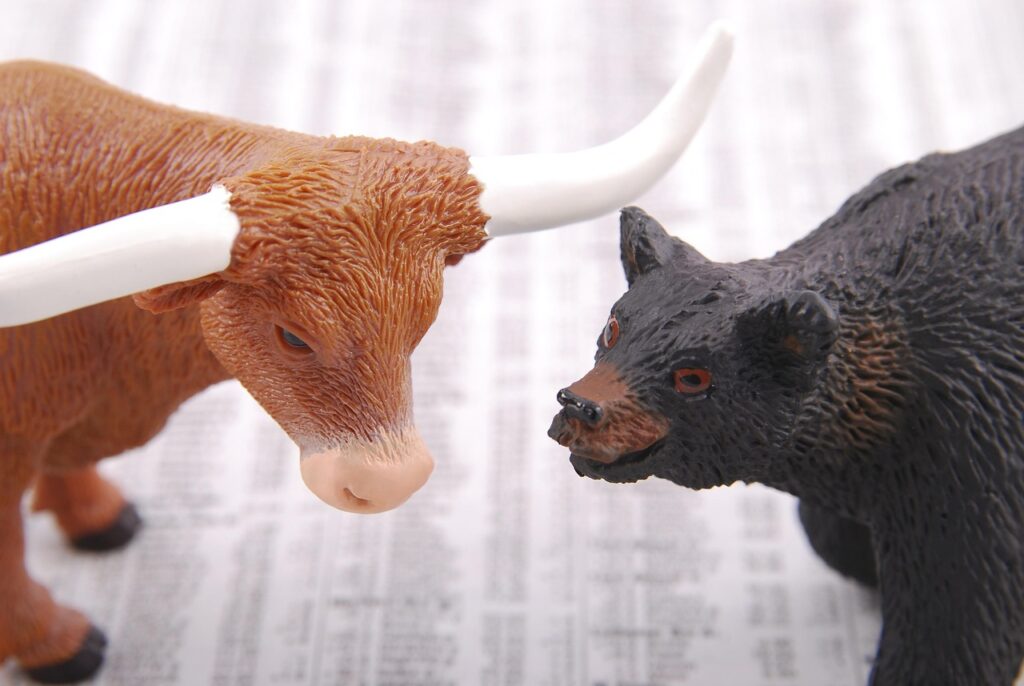When I first started trading, “bull market” and “bear market” sounded like fancy Wall Street jargon everyone but I understood. Don’t worry if you feel lost – I’ve been there. After years of trading (including some painful losses I wish I could forget), I’ve learned that understanding these market types isn’t just fancy talk – it’s essential for survival.
Table of Contents
Bull Market vs. Bear Market: Cutting Through the Jargon
Let’s keep this simple: a bull market is when prices keep climbing higher. Think of a charging bull with its horns pointed up. Everything feels optimistic, people are buying more than selling, and there’s this energy that things are going well. Technically, when a major market index rises by 20% or more from its low, we’ve entered bull territory.
A bear market is the opposite – prices consistently fall. Picture a bear swiping its paw downward. There’s pessimism everywhere, investors are selling more than buying, and fear hangs in the air. When markets drop 20% or more from their high, that’s officially bear country.
How I Spot a Bull Market
Through years of staring at charts (sometimes way too late at night), I’ve found these reliable signs that bulls are running:
The Higher-Higher Pattern: This was my big “aha” moment. In bull markets, each peak is higher than the previous one (higher highs), and each dip doesn’t fall as low as the previous dip (higher lows). Once I started seeing this pattern, identifying bull markets became second nature.
Breakouts After Consolidation: Markets don’t just go straight up – they need breathers. When the price moves sideways for a while (forming patterns like triangles or flags) and then bursts upward, that’s usually a sign the bull market is charging ahead again.
Those Big Green Candles: When I see massive bullish engulfing candles appearing regularly on charts, I know there’s serious buying happening. These candles completely “swallow” the previous candle and signal strong momentum.
The Upward Slope: If I can draw a clean line connecting the swing lows that slope upward, that’s a bull market. I use this simple trendline technique constantly.
Riding Above the Averages: When price consistently stays above key moving averages (I prefer the 50 EMA), it’s telling you bulls are in control.
During bull markets, I’ve learned the best strategy is buying dips rather than trying to short rallies. Even when I’ve messed up my entries (and I have, plenty of times), the overall upward momentum often saved me.
When Bulls Start to Tire: Warning Signs
Just as important as recognizing a bull market is knowing when it might be ending. Here are the signs I watch for:
The First Lower High: This is often the earliest warning. After a series of higher highs, when the price fails to make a new high, I get cautious.
Breaking the Higher Lows Pattern: When the price drops below a previous low, breaking the pattern of higher lows, I take it seriously.
Breaking Down, Not Up: When the price consolidates but then breaks downward instead of upward, it tells me buyers may be losing control.
The Big Red Flags: Large bearish engulfing candles, significant gaps down, breaks below key trendlines or moving averages – these signals have saved me from holding too long in dying bull markets.
Bear markets used to terrify me until I learned how to trade them properly. Here’s what I look for:
The Lower-Lower Pattern: The opposite of bull markets – each peak is lower than the previous peak (lower highs), and each bottom is lower than the previous bottom (lower lows).
Breakdown After Consolidation: When price moves sideways but then breaks lower, it confirms sellers are still in charge.
Red Candles Dominate: Large bearish candles appearing frequently signal strong selling pressure.
The Downward Slope: A trendline connecting the swing highs that slopes downward confirms we’re in bear territory.
Staying Under Averages: When the price consistently remains below key moving averages, that’s a bear market signature.
I learned the hard way that fighting bear markets with long positions is usually painful. Instead, I look to short rallies to resistance or just stay in cash until conditions improve.
Bear Market Ending? Look for These Clues
Some of my best trades came from spotting the end of bear markets before others. Here’s what usually signals the bears are losing control:
The First Higher Low: This subtle shift, when the price doesn’t drop as low as the previous bottom, can be the first hint of changing momentum.
A Higher High Appears: When the price finally breaks above a previous peak, it often signals the downtrend is weakening.
Upside Breakouts: When consolidation patterns break upward instead of downward, it suggests buyers are gaining strength.
Green Shoots: Large bullish candles, gap ups, breaks above downtrend lines, and price moving above key moving averages – these are all signs I’ve used to spot potential bear market bottoms.
The Tricky Sideways Market
Not all markets are bullish or bearish. Sometimes they just chop sideways, making roughly the same highs and lows. I used to hate these periods until I learned to:
- Identify the range boundaries clearly
- Buy near support and sell near resistance
- Lower my position sizes and profit expectations
- Be patient and wait for a clear breakout
Why This All Matters
I can’t count how many times understanding market type has saved my trading account. When I stopped trying to short in strong bull markets or go long in persistent bear markets, my results improved dramatically.
The market has a flow to it, like a river’s current. Swimming with that current (trading with the trend) is so much easier than fighting against it. I’ve found that even when my entry isn’t perfect, trading with the market’s direction gives me more room for error.
The truth is, that most traders fail because they never learn to identify what kind of market they’re in. They take the same approach regardless of conditions, and the market eventually punishes that inflexibility.
Before placing your next trade, ask yourself: “Is this a bull market, bear market, or sideways market?” Then align your strategy accordingly. It sounds simple, but this one habit transformed my trading more than any indicator or system ever could.
Remember – in bull markets, focus on buying dips. In bear markets, look to sell rallies. And in sideways markets, play both sides from the extremes.


















